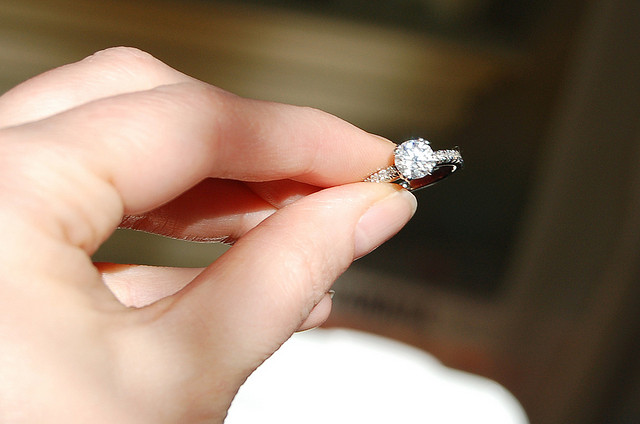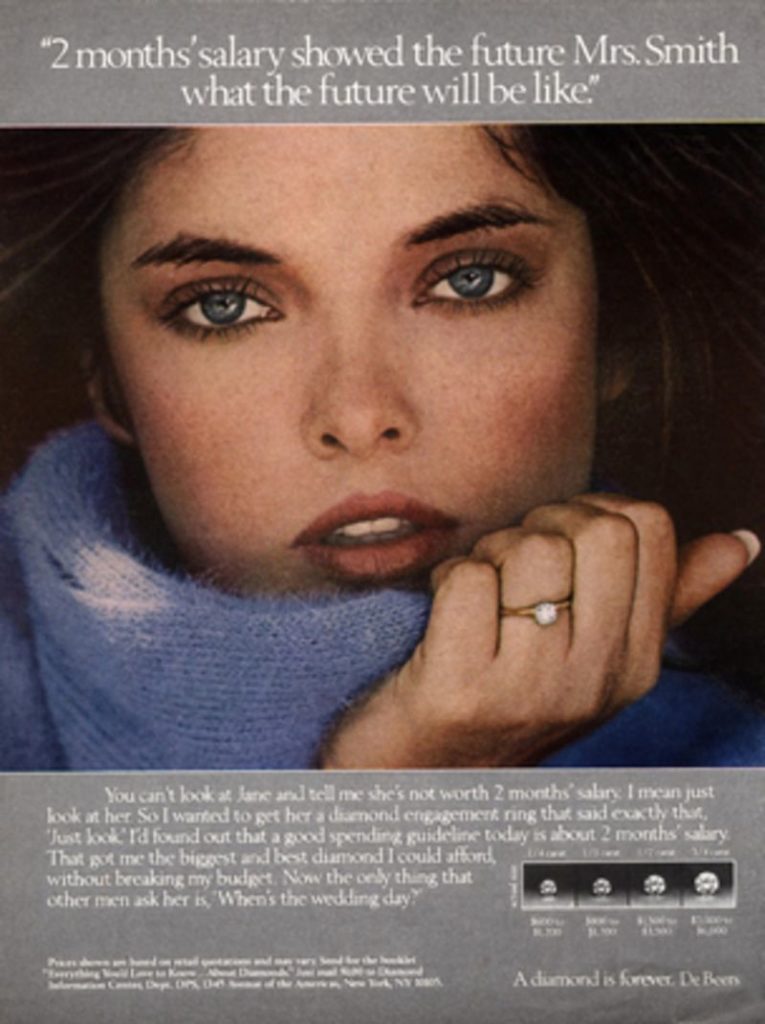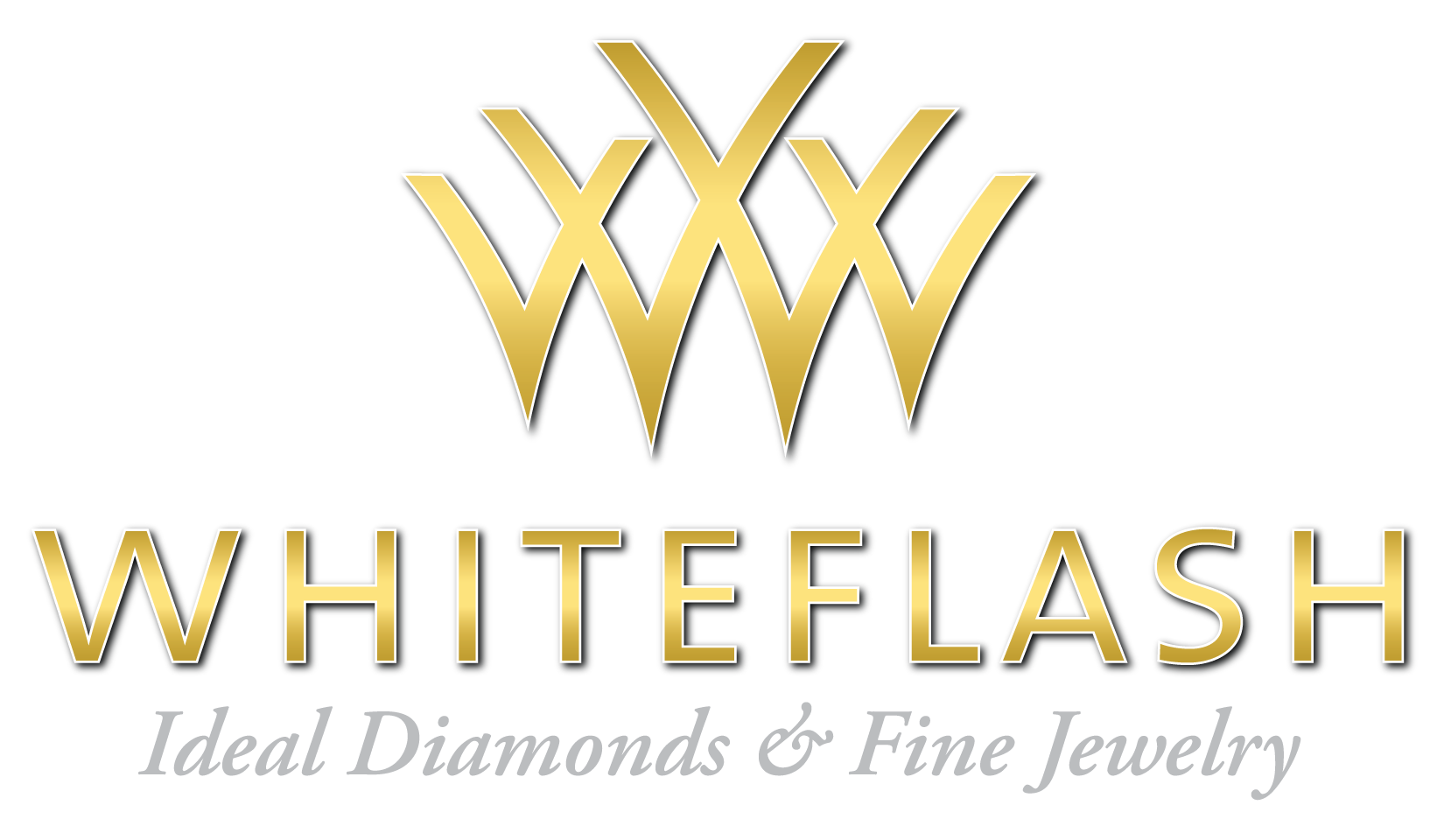
Should you spend three months’ salary on an engagement ring? Two months? One? These benchmarks for how much engagement ring to buy have been around for decades. But they’re not the right answer to how much you should spend on an engagement ring.
How much engagement ring to buy
When buying an engagement ring, you should spend as much as you want to, but no more than you can afford.
I know, that seems like a lame answer. But it’s true.
I first wrote about the topic of engagement ring budgets nearly 10 years ago on my financial advice website because I wanted to help people avoid going into debt for an engagement ring.
People get married at all ages, but most people are fairly young when they wed. Building a life with your betrothed is going to be expensive — from the wedding to a home to perhaps starting a family. You don’t want to start your new life together by adding on thousands of dollars of debt for an engagement ring.
Sure, we all want to have that fairy-tale proposal that she’ll remember forever, but how many months salary can you really afford to spend? Your marriage proposal should never put you in financial hardship! If you think that your special somebody is going to care about the ring size, then you may want to have an honest conversation with them about your financial situation.
When determining how much engagement ring to buy, start with what you can afford without going into debt. (You can put it on a credit card as long as you can pay it off in full!)
If you absolutely must pay for your engagement ring over time, try to look for a credit card that offers a 0% introductory APR for a year or more. Pay the ring off before the no-interest promotion expires.
Fortunately, you can build a beautiful diamond engagement ring on any budget. The key is to skip the chain jeweler stores. The bigger and fancier the store, the more you’re going to overpay for your engagement ring.
Reputable online jewelers like Blue Nile, James Allen, and Brilliant Earth offer the best selection of diamond engagement rings at up to 50% off the prices you’d pay in stores.
Other couples are spending less than you think
According to an article in London’s Daily Mail, a survey conducted in England revealed that the average amount spent by men in that country for an engagement ring is still “three.” That’s three weeks, not months.
The survey revealed that just over two-thirds of men responding to the survey spent less than one month’s salary on a ring for their beloveds.
Only 38 percent of the men in the survey said they told their fiancées what the rings cost. Buttressing that figure is the 45 percent of women surveyed who said they know how much their rings cost.
Where did ‘two months’ salary’ come from?
The notion that you need to spend two months’ salary on an engagement ring was invented as a marketing campaign for De Beer’s, the largest diamond cartel in the world. Here’s one of their ads:

Of course a diamond company would want you to spend that much on their product! It’s utterly ridiculous.
The average engagement ring definitely shouldn’t cost you two months of salary. So, what is the average cost of a diamond ring as found at a diamond retailer? According to the experts, the national average cost for an engagement ring is roughly $6,000. Although this may seem quite ridiculous, that’s a pretty standard engagement ring price.
The ad suggests that by overextending on a diamond, a man is somehow demonstrating he will provide a lavish future for his wife. There are a lot of problems with this concept. But financially speaking, I would argue that an average person spending that much on a ring is likely demonstrating they are reckless, not responsible, with money.
De Beer’s didn’t just invent the concept of spending two months’ salary on an engagement ring — they invented the entire concept of giving a diamond as a symbol of engagement.
The Great Depression of the 1930s wrecked havoc on the diamond industry. De Beer’s marketing campaign to get men to spend 1/6 of their annual salaries on diamonds before getting married saved the industry. Not surprisingly, they’ve clung to it ever since. You don’t have to.
How much engagement ring can you afford?
The amount you can afford to spend on an engagement ring should be whatever amount of money you can save over the course of several months without going into debt or avoiding other financial obligations. Wedding rings can be very expensive, especially if you get one with a large center stone, but this doesn’t mean that you should go broke buying a diamond.
I’m a financial journalist and consumer advocate. Yes, I earn commissions from jewelers on this website. But ultimately those commissions afford me the ability to help readers like you make wise informed decisions. And I do not want you or anybody else spending more than you afford on a diamond. As far as choosing between online retailers, diamond marketers, and you the consumer, I will always be on your side!
Ideally, you will be thinking of proposing long before you’re ready to get down on one knee. Use that time to put aside some money each month that you will use to buy your ring. The longer you save, the more engagement ring you can buy.
What you do not want to do is walk into a jeweler on the spur-of-the-moment and buy a $20,000 on jewelry store credit.
They might offer a come-on like no interest for 6 months. But unless you can pay off the ring before the 6 months are up, the ongoing interest rates of these kinds of loans are often 20% interest or more. In other words, an absolute rip-off that will be a financial albatross around your neck for years to come.
Buy only as much engagement ring as you can afford!
How can you save money on an engagement ring?
Heirloom or estate rings, non-diamond gemstone rings and lab-created diamond rings are all possible ways to buy an engagement ring for less.
Heirloom or estate rings
A family heirloom ring is probably the most meaningful type of engagement ring you can give your future wife. Even if you don’t have such a ring in your family, you can find absolutely stunning diamond rings at estate jewelers.
Estate jewelry is just a fancy word for used jewelry. And though used goods often come with a negative connotation, I can think of few things better to buy used than diamond jewelry.
Diamonds are the hardest substance on earth. They do not change and cannot get banged up even after decades.
Diamonds are not good investments. They aren’t a store of value that reliably appreciates over time like gold. When new, diamonds are sold at a large markup to their wholesale price.
When you buy a new diamond — even from an online jeweler with excellent prices — you will not be able to resell your diamond for what you paid. You will pay much less of a markup on estate jeweler. In other words, you will get more diamond for less money.
The thing about estate jewelry is that styles change over time. If you or your fiancée have your hearts set on a modern style ring, estate jewelry may not work. Conversely, an elegant design from a bygone era is sure to stand out and will arguably be even more special of a ring.
Alternative gemstones
Sapphire, ruby or emerald engagement rings make a unique and beautiful alternative to diamond rings.
Remember that De Beer’s — the diamond cartel — started the trend of giving diamond rings upon engagement less than 100 years ago.
It’s hard to argue that a ring is a touching symbol of eternal love, but there is no rule that it has to be a diamond.
And although no gemstone sparkles quite like a diamond, the colors of sapphires, rubies and emeralds will stand out on their own.
If you’re curious, try building your own gemstone engagement ring at James Allen.
Lab-created diamonds
Lab-created (or man-made) diamonds are real diamonds that are grown in a lab rather than deep within the earth. Often, you can buy an equivalent lab-created diamond for less than an earth-created diamond.
Lab-grown diamonds are a fascinating thing. Just a few decades ago, scientists discovered how to recreate the natural process of growing diamonds by subjecting carbon to immense pressure and heat in a laboratory.
The result are real diamonds that are so indistinguishable from earth-created diamonds that lab-makers must engrave their name and a serial number on every one.
More: Lab-grown diamonds vs earth-created diamonds: What’s the difference?
There are several advantages to lab-grown diamonds:
- They eliminate any ethical concerns that you are buying a diamond that mined with slave labor or traded in support of violence (so-called blood or conflict diamonds).
- They have superior color qualities (they are clearer and less yellow) than earth-created diamonds.
- They can be less expensive.
It’s worth noting that it’s possible for a lab-grown diamond to cost as much as an equivalent earth-created diamond. But as a rule, they are less expensive.
The bottom line: It’s your ring!
An engagement ring is a deeply personal token of love between you and your betrothed. How much you decide to spend on an engagement ring is as important as the style of ring you choose.
If you believe a ring should involve making a sacrifice to somehow demonstrate commitment, then go ahead and spend two or three months’ salary.
If you can’t (or don’t want to) spend that much money on a ring, that’s more than OK. Most people are spending a few weeks’ worth of income on their rings, not months!
What you also need to realize is that there are other factors that will determine how much you spend on a ring. For one, the type of metal that the setting is made of will make a difference, with some precious metals costing more than others.
You have yellow gold, white gold, sterling silver, and so much more to choose from. Yes, the cost of wedding bands can be quite high, and according to the American wedding study it can cost you around $6,000, which for most people is going to be at least a couple of months of salary, if not more.



